Table of Contents
- Conditions under Natural Ventilation
- Pressure and Exhaust Systems
- Equipment and General Arrangement for Mechanical Ventilation
- Data Collected before Mechanical Ventilation System Planned
- Two Standards of Measurement
- Averages Plotted on the Mine Map
- Amount of Air Necessary for Each District Calculated
- Natural Ventilation Utilized Where Possible
- Natural Ventilation Supplemented by Mechanical Means
- A Good Working Atmosphere Dependent on Several Factors
- Increased Velocity of Air Improves Working Conditions
- Changes after Mechanical Ventilating System was Completed
- Advantages of New Ventilating System
The Copper Queen mine is composed of seven divisions which are operated through the following shafts:
The workings of the different shafts are connected by motor-haulage drifts on the even numbered levels. The general location of the orebodies and workings is illustrated by the vertical projection of orebodies of the district as shown in Fig. 1.
The Uncle Sam, Southwest, and Czar workings have many connections to the surface through raises and extensive cracks that were caused by moving ground. These divisions are cool and are ventilated entirely by natural means.
The Holbrook is ventilated partly by natural and partly by artificial ventilation, while the Spray, Gardner, Lowell, and Sacramento are ventilated entirely by mechanical means.
In some of the divisions mentioned above a considerable quantity of air exhausts through shafts of adjoining properties.
mine shafts
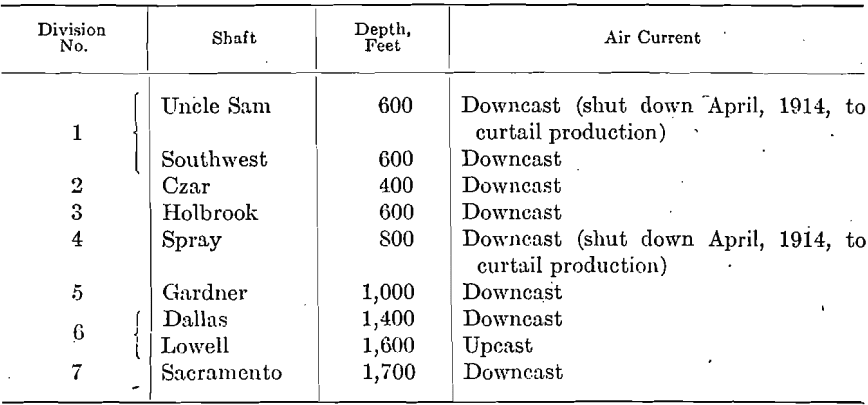
Conditions under Natural Ventilation
Several Mine Fires Occurred
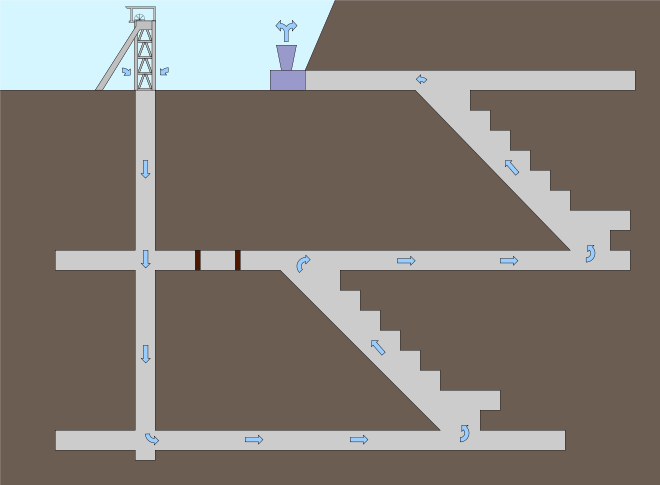
During the last few years several mine fires menaced both life and property. The most serious mine fire was that of the Lowell, which occurred during 1911. The district where the fire originated was between the 1,000 and 1,200 ft. levels. The orebody contained a high percentage of sulphur, and the gob a large amount of pyrite; as stoping progressed the friction between the blocks of sulphides increased, due to moving ground. Oxidation of pyrite and timber was also an important factor. The temperature increased until the timbers took fire, which in turn started fire in the sulphide ore. The gases resulting from this fire, such as SO2, and distillation products of wood, came through the upcast shaft and caused considerable damage, thus putting the shaft out of commission. By reason of broken ground, the fire could not be sealed off at that time, which made necessary the repair of 800 ft. of the shaft by men using oxygen helmets.
Several fires also occurred at different times in some of the other divisions. They were particularly dangerous under conditions of natural ventilation as gases and smoke usually entered the workings. One of the reasons, therefore, in planning a system of mechanical ventilation was to provide a better means of control immediately after a fire started.

General Working Conditions Investigated
During 1912, the company decided to make an investigation of the general working conditions of the Gardner division. By reason of the scarcity of connections with other mines this division contained the poorest working conditions and presented the greatest problem for ventilation. Readings were taken on natural air currents as to their velocity, volume, direction, temperature, relative humidity, CO2 content, etc. This indicated that even though the entire mine seemed to be hot the average temperature was not high, varying from 75 to 100° F. The relative humidity, however, was exceptionally high everywhere in the mine, ranging from 90 to 100 per cent.
The CO2 was under 1 per cent, in the general run of working places and from 1 to 3.5 per cent, in exceptionally remote workings. The velocity and volume of the air currents were very low. Moisture was deposited on timbers and the sides of drifts, making the mine damp; a species of fungi covered a large percentage of the timbers. About 225 men worked in this division on each shift, and from the standpoint of efficiency the quantity of fresh air per man per minute was not all that was desired. Men in hot stopes had to be changed every two or three days on account of the heat, and in this way by the time a man was familiar with the workings of his stope he was put into another place. Consequently, all the men who had fairly good working conditions had to share the ordeal from time to time, by working in these undesirable places.
It was the custom when conditions became particularly bad to drive new air connections. In a few instances they proved beneficial, but in the large majority of cases the quantity of air which passed one way or the other was so small that the effect was negligible.
Pressure and Exhaust Systems
At first, plans were formulated and data obtained, as described under Planning the System of Mechanical Ventilation, for both the pressure and exhaust systems. After the merits of each were carefully considered, the pressure system of ventilation was adopted. According to this system, all mine fans were placed underground on the deepest working levels of the different divisions so as to draw the air down the intake shafts, force it through the workings and stopes, and exhaust it to the surface through upcast shafts.
Reasons for Adopting Pressure System
The reasons for adopting the pressure system instead of the exhaust are as follows:
1. More Practical.—Since all the deep shafts of the Copper Queen are in operation and a large amount of work is done around each, as for example, men going on and coming off shift, handling timber, tools, and supplies, etc., it would not be practical to have an exhaust fan on the surface near the collar of the shaft.
In the Gardner, a subway below the collar of the shaft would be out of the question. Consequently, a large air-tight chamber, inclosing nearly the entire head frame, would have to be built if a suction fan were used. This arrangement would be expensive and unsatisfactory.
2. Better Control of Mine Fires.—The pressure system is the more advantageous in case of mine fires. With this arrangement, the entire workings are under pressure and the gas or smoke from a mine fire may be coursed to exit through neighboring shafts that are not in operation. Since the air is under considerable pressure at the bottom and sides of the present fire districts and each of the outlets over them is provided with regulator doors, the quantity of air passing through the fire zone can be increased or diminished at will and the fire consequently can be brought under control more readily than with the exhaust system.
3. Greater Efficiency.—Since the Spray, Gardner, Dallas, and Sacramento shafts are natural downcasts, the mine fans were placed underground so as to take advantage of these circumstances and multiply the volume of the natural downcast from five to ten times. The pressure system, therefore, has the advantage of the additional natural ventilation, which evidently would be lost with the other system; and more power would be required for the same quantity of air if the natural downcasts were changed to upcasts by suction fans.
4. Greater Safely.—Experience in the Lowell mine fire showed that in the event of the connections being closed between the fire and the suction fan, there is a possibility of smoke and gases entering the workings below and endangering the men. In the adopted system, the maximum air pressure is below the fire district, which makes it impossible for gases to go down, even if bulkheads of a sealed fire district should be opened suddenly by caving ground.
At present a churn-drill hole is being put down to a depth of 1,100 ft. over the old Lowell fire stopes. When this is completed water will be run in to cool the district. No trouble is anticipated since this was thoroughly tried at the Holbrook, where a large amount of water was turned into churn-drill holes and no smoke or gases were taken down against the pressure of the mine fan.
Equipment and General Arrangement for Mechanical Ventilation
The following pages give an outline of the general mechanical ventilating system which was adopted at the Copper Queen mine.
Combined Natural and Mechanical System
Because of the many openings to the surface, the natural ventilation is satisfactory from the surface to the 400-ft. level in the Holbrook division. Below this level mechanical ventilation is used, as indicated in Fig. 2. There is a 20-in. blower on the 600-ft. level, which delivers 8,000 cu. ft. of air per minute. Since very little stoping is done between the 400- and
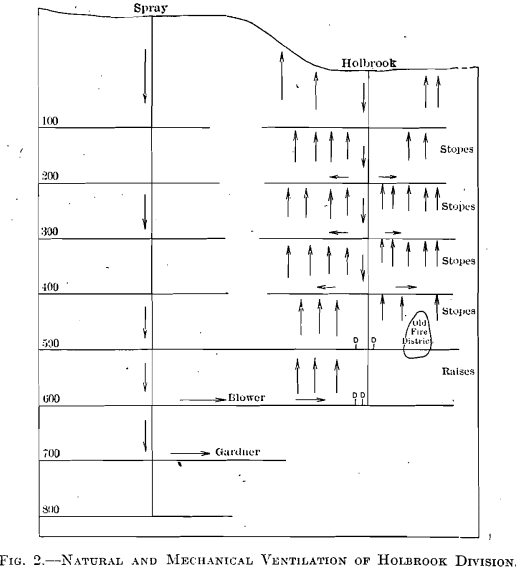
600-ft. levels, the blower is operated principally to keep a pressure around the old fire district to prevent any gases which may escape from entering the workings.
The outlines of the natural and mechanical ventilating system of the Gardner division are shown in Figs. 3 and 4. The arrows indicate the direction of some air courses and DD represents a few double doors. On the 900-ft. level, there is a Sturtevant mine fan delivering 72,000 cu.
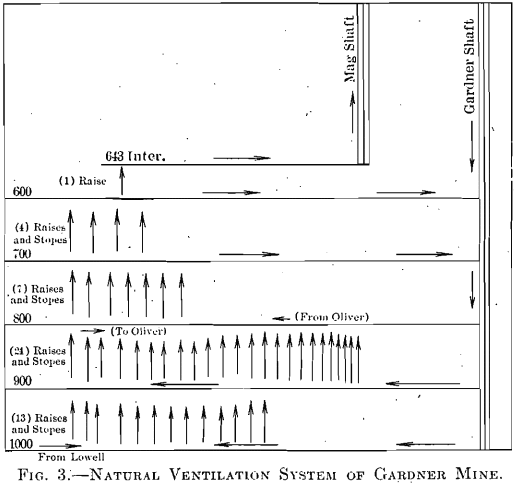
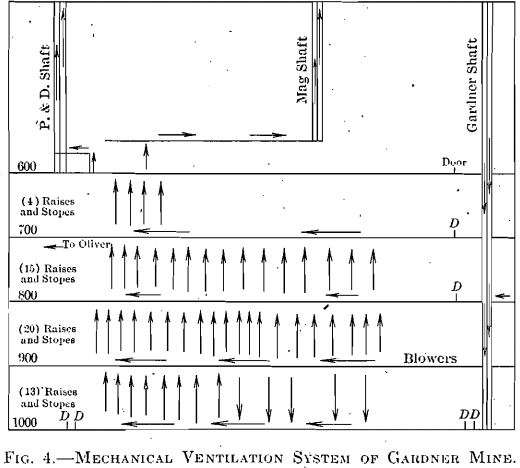
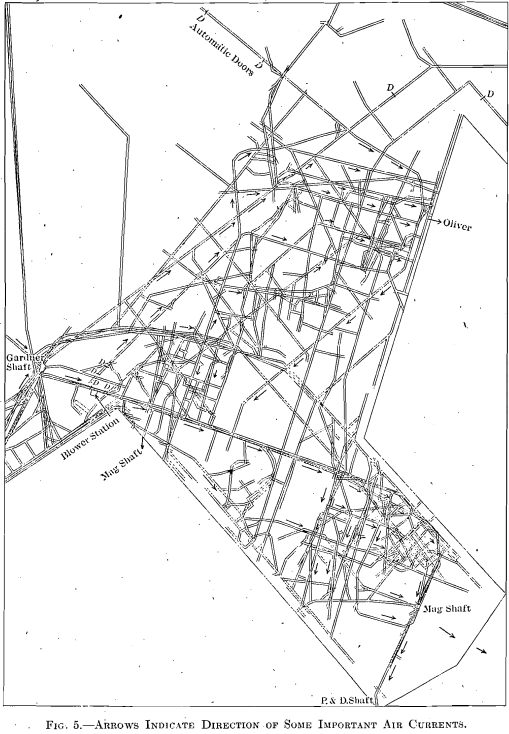
ft. of air per minute against 1 3/8 in. of water pressure. About 32 h.p. is being used. The combined level map (Fig. 5) illustrates the new connections which had to be driven, also the various directions of air courses when superimposed on one plane. There are 22 hand doors and two large doors on motor tracks, called automatic doors.
The mine fan draws the air down the Gardner and Spray shafts and forces the total quantity into the workings on the 900 level. Part of this air goes down to the 1,000 ft. and later comes up to the 900 ft., from whence all the air passes through stopes to the 800-, 700- and 600-ft., levels, and exhausts through abandoned workings and upcast shafts. On the 1,000-ft. level the pressure is built up by the use of automatic doors. These doors not only hold the pressure, but also allow the air to circulate, freely on the 1,000-ft. level. The usual speed of motor trains passing
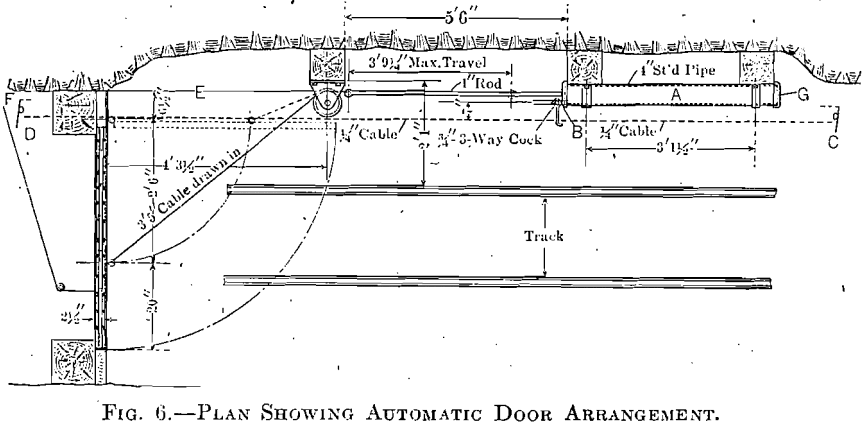
through these doors is about 7 miles an hour. The doors are 350 ft. apart. The arrangement for automatically opening the door is shown in Fig. 6.
Operation of the Automatic Door.—When the motor comes in the direction of C to D, the motorman reaches out and moves the lever C in the direction the motor is going. This opens the 3-way valve B, admits compressed air into the cylinder A and opens the door. When the train has passed through the door the motorman throws the lever D, which releases the compressed air and the door closes, assisted by the weights E and F. The valve G controls the speed of opening and closing of the door. The wires between C and D are crossed so that the levers are always moved in the direction the motor is going in opening and closing the door. The distance between lever C and the door is 70 ft., which allows ample time for the door to open when the motor is coming at an ordinary rate. The distance between D and the door is 175 ft. This makes it possible for a trip of cars to be in front of the motor on the return and at the same time allow the door to be opened. The cost of upkeep is small and the entire equipment only requires the amount of attention usually given to any machine.
The automatic doors are used on motor tracks only, while small hand doors are used in all ordinary drifts. The standard hand door is 6 ft. 6 in. high, 3 ft. 9 in. wide and 2¼ in. thick, made up of 1-in. boards with paper between the two thicknesses. The posts of the door frame are 6 by 10 in. by 6 ft. 6 in. and the cap 6 by 10 in. by 4 ft. 3 in. The motor
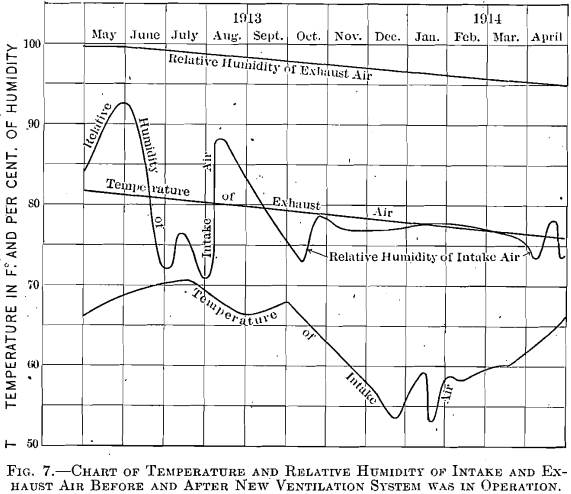
tracks are mounted on a timber sill set in concrete. The space between the bottom of the door and the sill is filled with concrete, except for clearance spaces for the flanges of the car wheels. The spaces between the door frame and the walls and roof are likewise filled with concrete. The automatic door is 6 ft. 11 in. high by 4 ft. 4 in. wide made of 1 by 12 in. boards faced on both sides with ¾ by 2 in. flooring.
Air Jets Used in Hot Workings.—Formerly small electric blowers were used to ventilate hot raises and stopes. These poorly-ventilated places were usually some distance from the shaft, which required a considerable investment and long electric cables. Instead of using these blowers an air jet was designed and tried for workings of this type. The jet had eight 1/16-in. holes and was placed in the center of a 14-in. funnel which was connected to a, 10-in. pipe. About 800 cu. ft. per minute was delivered at the end of 50 ft. of pipe of this kind. The cost of compressed air is comparatively small and is less than one-third the cost of electrical power, when used in these particular instances. Of course the jet is only used until the connection is made. After connections are made considerable quantities of air pass through these drifts and raises from the large blower, and the ventilation is generally satisfactory.
Lower Temperature and Relative Humidity
The chart, Fig. 7, illustrates the decrease in temperature and relative humidity of the intake and return air before and after the blowers were started. On account of the large amount of moisture in the ground and also the wet conditions of moist drifts and workings, it took about four months to dry the timbers and working places after the new ventilating system was in operation.
Velocity and Volume of Air Increased
The blowers were started June 1, 1913, resulting in an increase in velocity of the intake air from 65 ft. per minute on June 1, to 1,000 on June 30 and 1,160 on July 31. The volume also increased from 10,000 cu. ft. per minute on June 1, to over 60,000 on June 30 and 70,000 on July 31. The reduction in the temperature and humidity was not so marked as the increase in velocity and volume. The division in general, however, seems much cooler and the environment is comfortable.
Lowell and Sacramento Divisions Ventilated Jointly
The natural and mechanical ventilation systems of these divisions are outlined in Figs. 8 and 9. There is a Sirocco blower (capacity 35,000 cu. ft.) on the 1,400-ft. level of the Dallas shaft, forcing the air towards the Lowell against a 1 3/8-in. water pressure and another blower on the 1,600-ft. Sacramento (capacity 45,000 cu. ft.) operating against a 1½-in. water gauge. The reason for the higher pressure in the Sacramento is to have the air from that level join the Dallas air on the 1,400-ft. level and from there rise through the workings to the 900-ft. level of the Lowell, and exhaust through the two shafts as indicated in Fig. 9.
Part of Fire District being Cooled.—An example of the effect of large volumes of air passing through a district, part of which is on fire, may be obtained from the 13-10-10 stope. Here the temperature has been reduced from 87 to 83° F. To accomplish this result, 15,000 cu. ft. of air per minute was driven through this stope from Sept. 1, 1914, to Feb. 1, 1915, a period of five months. Before this blower was started the humidity was about 98 per cent, and the velocity of the air was scarcely noticeable. After the 15,000 cu. ft. of air per minute was driven through the stope, even though the temperature showed a very little difference, the humidity dropped to about 80 per cent, and the velocity increased to about 400 ft. per minute. As a result the stope seems cool and the men can do efficient mining. This small reduction in temperature also shows that it requires a large quantity of air circulating a long time in a fire district to cool the country rock.
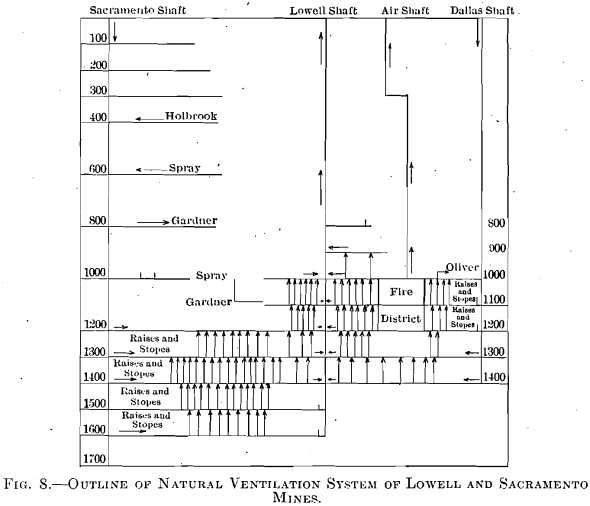
The velocity and volume of air have been increased through all the stopes and workings and although the temperature throughout the entire mine has not been lowered much, nevertheless the workings seem much cooler on account of the increased velocity and volume and decrease in humidity.
Data Collected before Mechanical Ventilation System Planned
In order to plan the general system of mechanical ventilation of the Copper Queen, as outlined above, the following methods of obtaining data for a working basis were pursued. It may also be stated here that these methods would be the same for either pressure or exhaust systems.
Instruments for Determinations.—The following instruments were used in determining the temperature, relative humidity, velocity and volume of mine air: The anemometer, water gauge, hygrometer, and barometer.
Recording of Data.—Data were readily obtained in the form of daily reports.
Barometric readings, when taken occasionally in important places, were satisfactory for all practical purposes, while readings with the anemometer and hygrometer were made daily for several months.
The following is an example of the daily report blank used at the Copper Queen:
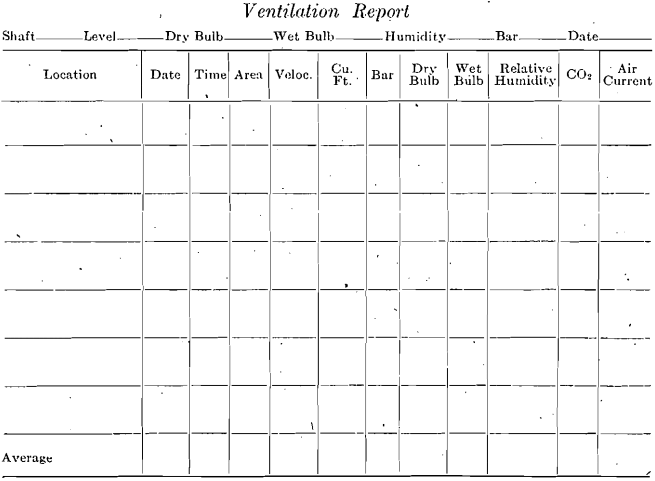
Two Standards of Measurement
There are two standards by which the degree of ventilation in a mine may be measured: (a) a quantity standard—that is, the quantity of pure air entering the mine per man, per minute; or, (b) the quality standard—this being determined by the amount of impurity present. These standards are entirely different and each one has its particular application.
The quantity standard is less expensive, more practicable, and is the method most generally used in both coal and metal mines. The quantity standard was used in all drifts, raises, and places where there are air currents that can be detected and measured with the anemometer. This method is also the more important because the increase of velocity of air materially affects the efficiency of the men.
The quality standard is very expensive and its application is only necessary in exceptional cases. It has only a remote bearing on the efficiency of the men, but occasionally it is found advisable to have accurate determinations made on several samples of mine air.
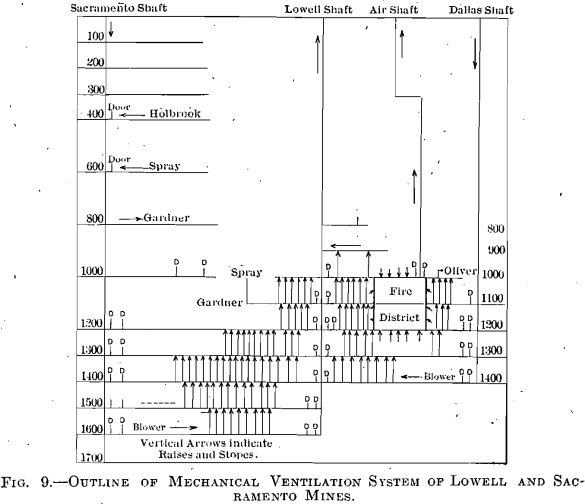
Averages Plotted on the Mine Map
The data secured as explained in the paragraph on “Recording of Data” were averaged every week. Blueprints of the different levels of the mine were made and the monthly averages written on them in their proper places. The direction of air currents was also indicated by arrows, especially where readings were made with the anemometer.
Amount of Air Necessary for Each District Calculated
In order to calculate the amount of air necessary for each district, it was necessary to take into account the following:
- Number of men and animals in each district.
- The production of CO2, or other gases, as shown by the chemical analyses.
- Relative humidity.
- Temperature.
- Amount of explosives used.
- The distance from currents of good air.
- The number of lights.
- Air leakage.
- Friction of the air currents.
- Number of splits of the air current.
- Method of distribution.
Natural Ventilation Utilized Where Possible
In order to get the most economical system, it was necessary to utilize all possible natural ventilation and secure the proper distribution of the air. The latter is extremely important because the efficiency of the ventilating system depends largely on the proper distribution of the air currents. The arrangement of air currents by mechanical means was designed to coincide with that of natural ventilation in nearly all cases.
Natural Ventilation Supplemented by Mechanical Means
In the divisions where natural ventilation was not sufficient, the natural air currents were strengthened by mechanical, or artificial means, by installing large mine fans.
A Good Working Atmosphere Dependent on Several Factors
There is a diversity of opinion among authorities on what constitutes ‘‘a good working atmosphere,” and to what extent it will be economical to ventilate a mine, considering the cost of installation, maintenance, and power. The quantity of air necessary for the ventilation of one mine would be inadequate for the ventilation of another. The same can be said regarding the quantity of air per man per minute, consequently every mine is an individual problem, and while generalities are made, to get the greatest efficiency of a ventilating system, a detailed study of the mine must first be made, and the new ventilating system adapted to meet the particular needs of each mine.
In a number of States the quantity of air in coal mines required by law is usually specified, as, for example: The Anthracite Mine Law of Pennsylvania specifies a minimum quantity of 200 cu. ft. per man, per minute. One of the modifying clauses of the above law stipulates that the amount of air in circulation should be sufficient “to dilute, render harmless, and sweep away, smoke and noxious or dangerous gases.”
Even in coal mines, therefore, where the problems of ventilation have not the intricacies found in metal mines, there is no fixed standard upon which to base figures for “a good working atmosphere” or an efficient ventilating system.
Experience in ventilation of the Copper Queen mine has shown thus far that in poorly ventilated areas, comfort, efficiency, and economy are obtained by increasing the natural ventilation with mechanical means until the following conditions are obtained: Temperature, 77° F.; relative humidity, under 85 per cent.; velocity of air in working places at least 100 ft. per min.; volume of air in working places at least 250 cu. ft. per man, per minute. This may be termed a good working atmosphere and is the present standard for this camp.
In general, if the above velocity and volume are maintained in any working place it will not be necessary to make chemical analyses, because the percentages of CO2, CO, NO2, and SO2 gases, etc., as well as the temperature and humidity, will be low and require no attention, except in a few instances.
Increased Velocity of Air Improves Working Conditions
Formerly there were several examples of stopes in the Copper Queen mine which were similar to the following:
In No. 8-13-5 stope of the Gardner division, the readings in working places for May 28, 1913, were
Velocity…………………………………………………….10 ft. per minute (approx.)
Volume…………………………………………………….10 cu. ft. per min. (approx.)
Temperature……………………………………………….84° F.
Humidity………………………………………………….96 per cent.
A small 5-h.p. blower was forcing air into the stope. The miners were uncomfortable in this stope and complained about the excessive heat.
On Oct. 1, 1913, after the new ventilating system was installed, the following readings were made in the same stope:
Velocity………………………………………………100 ft. per minute
Volume……………………………………………..500 cu. ft. per min.
Temperature…………………………………………………84° F.
Humidity………………………………………………..90 per cent.
The same miners mentioned above happened to be working in this stope on Oct. 1, 1913, and they remarked “the stope is not near as hot as it used to be and we can work much better.” The men did not sweat excessively in this atmosphere, and the greater comfort experienced by them was due to the increase in velocity, which also means an increase in volume, with lower humidity, and not to the temperature, as it was the same in both cases.
When miners work in hot mines, drifts, and stopes, they generally neglect their personal safety. It was a frequent occurrence for the shift boss to enter a working place and after asking miners to bar down the back to discover that they had been working under loose boulders for several hours. It is evident, therefore, and proved by the rate of accidents, that men are on the alert and look out for personal safety far more in a comfortable atmosphere than in hot, damp, and disagreeable places.
In regard to efficiency, the tonnage per man shift has increased with the increase in the velocity and volume of air resulting from the installation of large mine fans. The greater efficiency of the men may be partly assigned to better organization and cooperation and partly to the psychological effect resulting from good ventilation. For instance, in the language of the average miner, he “tries to make a showing every day.” In a comfortable atmosphere, he will take an interest in his work, and go about it in a more contented spirit than he could possibly do under hot, unfavorable, unhealthy, and depressing conditions.
A special effort, therefore, is constantly being made at the Copper Queen to increase the velocity of the air in all the raises, drifts, and stopes, and keep the ventilating system up-to-date with the newly developed workings.
Changes after Mechanical Ventilating System was Completed
Development Work and Ventilation System Planned Together
In general, the mine department makes an effort to plan development work in line with the ventilating system, as well as for prospecting purposes. The drifts are usually driven about 5 by 8 ft. and raises are run two compartments each, 50 in. in the clear. Recently standard raises have been adopted throughout the mine, and the timber compartments as well as manways have also been standardized. Rails are put over timber compartments to allow free passage of air (see Fig. 10) and manways have been made larger to permit more air to pass through them and at the same time to make it easier for the men to go up and down. Also when an orebody is found it is properly developed and prospected before stoping is commenced. In this way ventilation is really first established, while the orebody is being brought into a condition for stoping operations. This is a great help in the ventilation of stopes.
Square-Set and Shrinkage Stopes Ventilated Easiest
Recently other methods of stoping have been giving good results besides the original square set. Shrinkage, cut-and-fill and top-slice stopes have progressed far enough to show that each method has its particular application to certain kinds of ground. In ventilating stopes under these systems, probably the most easily ventilated are the square-set and shrinkage stopes. Next to these are the cut-and-fill, and the most difficult the top-slice stopes. However, in all cases at present where the top slice is being used, separate drifts and raises were driven to facilitate
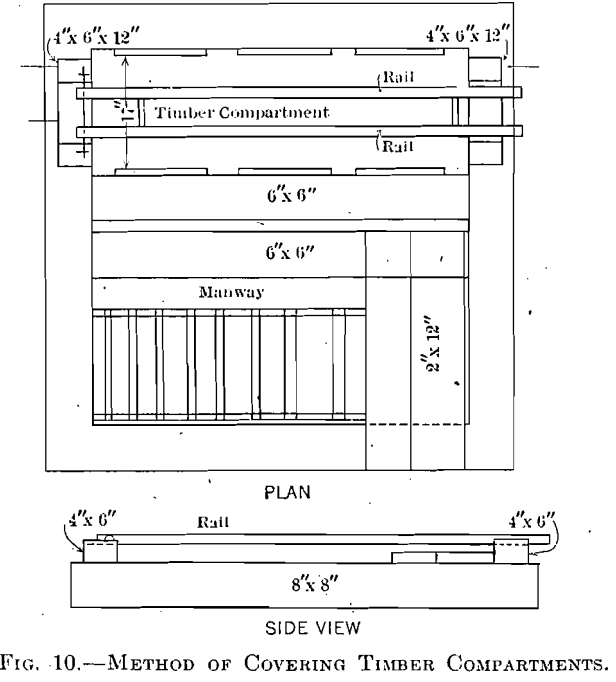
the handling of timber and tools and at the same time to give connections for ventilating purposes. Consequently, the top-slice stopes have about the same temperature and humidity as found in the square-set sections.
Advantages of New Ventilating System
- A smaller quantity of compressed air is used for ventilation.
- All possible natural ventilation is utilized and the general direction of air currents is the same for both natural and mechanical ventilation.
- There is a decrease in temperature and a lower percentage of humidity and CO2 throughout the mine, which means healthier working conditions.
- A saving of eight 5-h.p. blowers was made, as these have been removed from the mine.
- The five lower divisions are under pressure, which partly acts as a check in preventing some mine fires from crossing the Copper Queen side lines, as for example, the proximity of one mine fire near the Gardner workings.
- Less decay of mine timbers.
- The volume of air has been increased from 60 cu. ft. of air per man per minute, to about 300 cu. ft.
- Formerly a large amount of moisture kept the timbers and working places in a damp condition and a species of fungi also covered most of the timbers. Since the mine fans were started, a large amount of water is removed daily from each division by the air currents so that the mine is comparatively dry and the fungi have disappeared.
- The increase in velocity and volume of air resulted in the greater efficiency of the men.
- The new ventilating system is advantageous to the mines adjacent to the Copper Queen mine; there is a great deal of broken and stoped ground along side lines permitting a large amount of air to escape through these avenues and ventilate stopes beyond the Copper Queen boundary.
